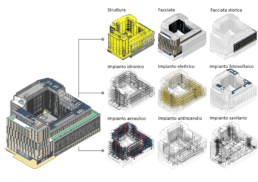Reviewer 2018
REVIEWER 2018
Fabio Bianconi, Università di Perugia, Italy
Stefano Brusaporci, Università dell’Aquila, Italy
Michele Calvano, Politecnico di Torino, Italy
Marco Carpiceci, Sapienza Università di Roma, Italy
Domenico D’Uva, Politecnico di Milano, Italy
Marco Filippucci, Università di Perugia, Italy
Elena Gigliarelli, Itabc-CNR, Italy
Carlo Inglese, Sapienza Università di Roma, Italy
Alfonso Ippolito, Sapienza Università di Roma, Italy
Alessandro Luigini, Università di Bolzano, Italy
Giovanna Massari, Università di Trento, Italy
Ivan Paduano, Sapienza Università di Roma, Italy
Leonardo Paris, Sapienza Università di Roma, Italy
Alberto Raimondi, Università Roma Tre, Italy
Michele Russo, Sapienza Università di Roma, Italy
Mario Sacco, BBIM Expert, Italy
Alberto Sdegno, Università di Trieste, Italy
Valeria Zacchei, PhD BBIM Expert, Italy
Reviewer 2017
REVIEWER 2017
Leonardo Baglioni, Sapienza Università di Roma, Italy
Stefano Brusaporci, Università dell’Aquila, Italy
Michele Calvano, Politecnico di Torino, Italy
Marco Carpiceci, Sapienza Università di Roma, Italy
Matteo Clemente, Sapienza Università di Roma, Italy
Elena Gigliarelli, Itabc-CNR, Italy
Carlo Inglese, Sapienza Università di Roma, Italy
Giovanna Massari, Università di Trento, Italy
Ivan Paduano, Sapienza Università di Roma, Italy
Leonardo Paris, Sapienza Università di Roma, Italy
Alberto Raimondi, Università Roma Tre, Italy
Michele Russo, Sapienza Università di Roma, Italy
Mario Sacco, BIM Expert, Italy
Marta Salvatore, Sapienza Università di Roma, Italy
Valeria Zacchei, PhD BIM Expert, Italy
Index Volume 3
INDEX
Editorial
C. Bolognesi, G.M. Valenti
Spherical Panoramas for Architectural Surveying. From image to 3D model
M.Calvano
Parametric design of a temporary transformable pavillion.
F. Maragaggia
BIM (and) Design. Towards an integrated approach
P. Belardi, V. Menchetelli, A. Franchi
Digital Computing as a tool for analyzing urban patterns. Comparing two neighborhoods built around Twenties in Rome and in Teheran
A. Del Monaco, S. Dolatkhah
Geometry of the domes. 3D modelling aimed to interpret the domes’ shape in Guarini’s treatises.
R. Spallone
Oyster chair. Virtual reality meets furniture design
A. Tedeschi, G. Sorrento
Index Volume 2
INDEX
Editorial
L. Inzerillo, F. Ruperto
New UMC headquarters in Riyadh, Saudi Arabia
M. Benga, M. A. Russo
Building Information Modelling for management and maintenaice of “L’Aquila – Smart Tunnel”
S. Brusaporci, P. Maiezza, A. Tata
From Geospital Data to Information Modeling
P. A. Ruffino, M. Del Giudice
The definition of the Level of Reliability: a contribution to the transparency of Historical-BIM processes
C. Bianchini, S. Nicastro
BIM as a control tool: Recovery of bus parking areas and passenger spaces in the COTRAL exchange nodes of Ponte Mammolo in Rome
M. G. Cianci, D. Calisi, M. Molinari
Test for interoperability: from theory to practice
G. Acampa, M. Grasso, C.M. Parisi, A. Pirrera
Computational design in the HBIM process
F. Sampietro, M.L. Masciopinto, I.W.J. Cincotta, G. Bergonzoni
Index Volume 1
INDEX
Editorial
T. Empler, M. Lo Turco
H-BIM modeling and historical reconstruction of architectural heritage
S. Scandurra, M. Pulcrano, C. Tarantino, A. Di Luggo
Heritage BIM: methodological reflections and interoperability with numerical simulations
E. Gigliarelli, F. Calcerano, M. Calvano, F. Ruperto, M. Sacco, L. Cessari
Towards a practice of BIM: three case studies
Alberto Cristofolini, Giovanna a. Massari
Perugini’s tree house – BIM ante litteram
A. Raimondi, F. Ripoli
A winning strategy in a BIM process
M. Sarrocco, A. Reina Rojas
Between Caad and BIM
A. Sdegno
A BIM-based approach for building stock maintenance and management
Francesco Semeraro, Anna Osello, Niccolò Rapetti
Oyster chair. Virtual reality meets furniture design.
ABSTRACT
Is it possible to imagine new ways for conceiving every-day objects like furniture? Is a CAD palette the only possible human-computer interface for designers? Oyster chair offers a look into the future of modeling, which has the potential to be much more intuitive and artful.
Arturo Tedeschi, Gabriele Sorrento
Geometry of the domes. 3D modelling aimed to interpret the domes’ shape in Guarini’s treatises.
ABSTRACT
The article describes and interprets from a geometric point of view the shapes’ inventions of domes, through Guarini’s treatises, using 3D modelling. It also recognizes these shapes in some guarinian buildings.
Roberta Spallone,
Politecnico di Torino - Department of Architecture and Design
Digital Computing as a tool for analyzing urban patterns. Comparing two neighborhoods built around Twenties in Rome and in Teheran.
ABSTRACT
This paper has the scope to test digital computing as a tool to explore the qualities of urban design and patterns in modern city neighborhoods. The long-term research question is to develop a comparative matrix between traditional urban design categories (urban density, road geometries, public-private space, housing typologies) and the possibility to identify new computational categories after proposing some tests on selected case studies. The tests will compare two neighborhoods Quartiere delle Vittorie (1921, 28,000 inhabitants) in Rome and Lalezar (1925, 28,000 inhabitants) in Teheran. The study will propose original digital drawings and comparative analysis on the science cases.
Anna Irene Del Monaco, Saeed Dolatkhah,
Sapienza Università di Roma
BIM (and) Design. Towards an integrated approach
ABSTRACT
The inclusion of design objects or artworks in the information model of a building today involves the selection and inclusion of loadable families. But the artistic object can also be modeled as a family internal to the project file (in-place model), revealing the potential of an integrated approach between BIM and Design.
Paolo Belardi, Valeria Menchetelli, Alice Franchi
Università degli Studi di Perugia, Dipartimento di Ingegneria Civile e Ambientale
Parametric design of a temporary transformable pavillion.
ABSTRACT
This work illustrates a parametric design experience of a temporary pavilion, designed to adapt to different types of pre-existence by modifying its formal and functional characteristics accordingly.
The research carried out is based on the definition of an algorithm managed with Grasshopper, assembled specifically to elaborate the project and its iterations; the algorithm allows to obtain geometries and analytical data in real time, reducing to a few hours a process that would instead take weeks with traditional methods.
The works of temporary transformable architecture and, specifically, the pavilion-type give the possibility to conjugate, in both conception and simulation, geometric and structural aspects. The prototype carried out is based on a kit-of-parts system of structural nodes and bars, easy to assemble and disassemble. By minimizing the variety of structural elements it is possible to contain costs, thanks to mass production, and to maintain a great freedom of formal expression.
Modelling is based on the intersection between an ideally unlimited spatial lattice system and a context-dependent volume of containment. The basic geometries, ie points, segments and triangles, are organized into groups of data and then statically analyzed.
This theme was addressed following some reflections on the shared features of temporary architecture, noting that usually you come across pavilions with extremely short life, or mobile architectures that do not allow modifications. The task was to approach an architectural object that was not temporally, spatially or formally limited.
Furio Magaraggia,
University of Trento








